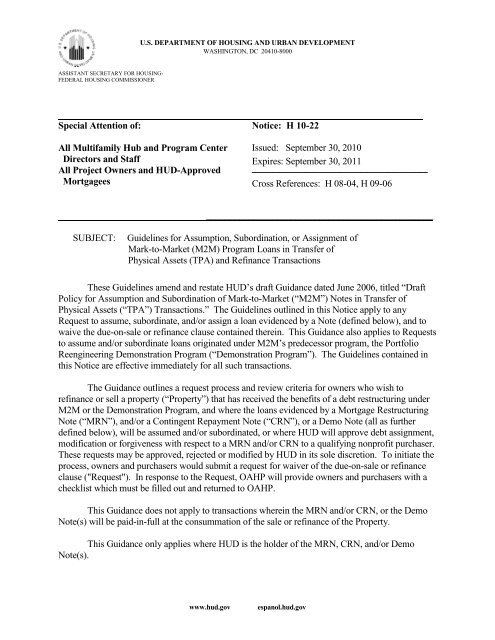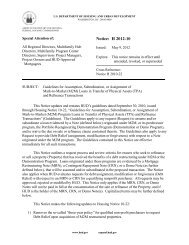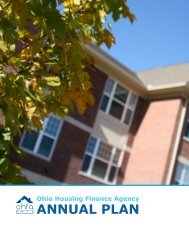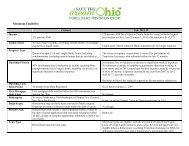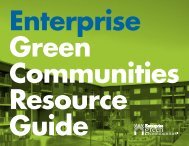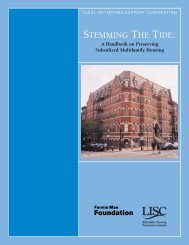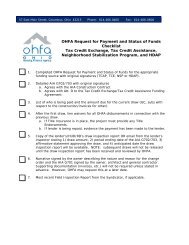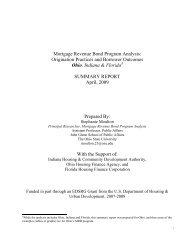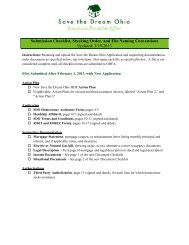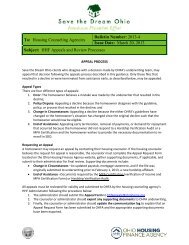Notice: H 10-22 - HUD
Notice: H 10-22 - HUD
Notice: H 10-22 - HUD
- No tags were found...
Create successful ePaper yourself
Turn your PDF publications into a flip-book with our unique Google optimized e-Paper software.
U.S. DEPARTMENT OF HOUSING AND URBAN DEVELOPMENTWASHINGTON, DC 204<strong>10</strong>-8000ASSISTANT SECRETARY FOR HOUSING-FEDERAL HOUSING COMMISSIONERSpecial Attention of:All Multifamily Hub and Program CenterDirectors and StaffAll Project Owners and <strong>HUD</strong>-ApprovedMortgagees<strong>Notice</strong>: H <strong>10</strong>-<strong>22</strong>Issued: September 30, 20<strong>10</strong>Expires: September 30, 2011──────────────────────────Cross References: H 08-04, H 09-06________________________________________________SUBJECT:Guidelines for Assumption, Subordination, or Assignment ofMark-to-Market (M2M) Program Loans in Transfer ofPhysical Assets (TPA) and Refinance TransactionsThese Guidelines amend and restate <strong>HUD</strong>’s draft Guidance dated June 2006, titled “DraftPolicy for Assumption and Subordination of Mark-to-Market (“M2M”) Notes in Transfer ofPhysical Assets (“TPA”) Transactions.” The Guidelines outlined in this <strong>Notice</strong> apply to anyRequest to assume, subordinate, and/or assign a loan evidenced by a Note (defined below), and towaive the due-on-sale or refinance clause contained therein. This Guidance also applies to Requeststo assume and/or subordinate loans originated under M2M’s predecessor program, the PortfolioReengineering Demonstration Program (“Demonstration Program”). The Guidelines contained inthis <strong>Notice</strong> are effective immediately for all such transactions.The Guidance outlines a request process and review criteria for owners who wish torefinance or sell a property (“Property”) that has received the benefits of a debt restructuring underM2M or the Demonstration Program, and where the loans evidenced by a Mortgage RestructuringNote (“MRN”), and/or a Contingent Repayment Note (“CRN”), or a Demo Note (all as furtherdefined below), will be assumed and/or subordinated, or where <strong>HUD</strong> will approve debt assignment,modification or forgiveness with respect to a MRN and/or CRN to a qualifying nonprofit purchaser.These requests may be approved, rejected or modified by <strong>HUD</strong> in its sole discretion. To initiate theprocess, owners and purchasers would submit a request for waiver of the due-on-sale or refinanceclause ("Request"). In response to the Request, OAHP will provide owners and purchasers with achecklist which must be filled out and returned to OAHP.This Guidance does not apply to transactions wherein the MRN and/or CRN, or the DemoNote(s) will be paid-in-full at the consummation of the sale or refinance of the Property.This Guidance only applies where <strong>HUD</strong> is the holder of the MRN, CRN, and/or DemoNote(s).www.hud.govespanol.hud.gov
This Revision to Housing notice 09-06 clarifies the roles of the Office of AffordableHousing Preservation, and Multifamily Office of Asset Management, in decision-making withregard to the subject transactions.2
Defined Terms1) “Assignment” - Transfer of MRN and/or CRN to a qualified non-profit entity (see “QNP”).2) “Assumption” - Transactions in which a purchaser will assume a seller’s obligations under theloans evidenced by a MRN and/or CRN, or Demo Note(s).3) “CRN” – Contingent Repayment Note originated under M2M, which is secured by amortgage that is usually in a third lien position encumbering a Property.4) “CRP” – Capital Recovery Payment, an incremental repayment of an Owner’s requiredcontribution toward M2M rehabilitation and transaction costs, with a market rate of return,subject to conditions as specified in M2M legal documents.5) “Demo Note(s)” – Notes originated under the Demonstration Program, typically secured bymortgages in a second or third lien position encumbering a Property.6) “MAHRA” – The Multifamily Assisted Housing Reform and Affordability Act of 1997, TitleV of the Departments of Veterans Affairs, Housing and Urban Development and IndependentAgencies Appropriations Act, 1998 (Pub. L. No. <strong>10</strong>5-65, 111 STAT. 1384, approved<strong>10</strong>/27/97, as amended, which established M2M.7) “Modification” – Changes made to loan documents that evidence or secure a Note toimplement the Guidance decisions. All assumptions, subordination or assignments under thisGuidance will include certain minimum modifications to loan documents in order to evidencethe change in responsible parties and eliminate the CRP (when applicable, as defined in theM2M loan documents). As a defined term used throughout this Guidance, however,Modification means changes made to a Note or the other documents that further evidence orsecure a Note beyond the minimum modifications, such as a change to the term, interest rate,payment terms, cash flow or surplus cash splits, and/or other changes consistent with thisGuidance, all of which must be in a form and substance satisfactory to <strong>HUD</strong>.8) “MRN” – a Mortgage Restructuring Note originated under M2M, which is secured by amortgage that is usually in a second lien position encumbering a Property.9) “Note(s)" - MRN, CRN and/or Demo Note(s).<strong>10</strong>) “Proceeds” - All cash and other consideration paid to or on behalf of the seller or seller’srelated entities, fees and consideration paid to the purchaser or purchaser's related entities,including, without limitation, developer fees, deferred payments to seller/affiliates, dispositionof project accounts, including operating reserves, escrows, security deposits and allocation ofaccounts payable, whether paid now or to be paid in the future.11) "QNP" – A nonprofit entity whose Request involves the acquisition of a Property, pursuant toand as more particularly defined in OAHP's Operating Procedures Guide, Appendix C. AQNP is the same as a Priority Purchaser under 24 CFR 401.2.3
12) “Remaining Proceeds” - Proceeds less any payment required by <strong>HUD</strong> to compensate <strong>HUD</strong> fora reduction in value of a Note, where applicable.13) “Request” - A request for <strong>HUD</strong> to allow the assumption, subordination, or assignment,forgiveness or modification, of a MRN and/or CRN, or the assumption and/or subordinationof the Demo Note(s), as applicable, in connection with a TPA or refinance transaction,submitted to <strong>HUD</strong> on the prescribed form.14) “Subordination” - Transactions in which the loan(s) evidenced by a Note will be subordinatedto a new first mortgage loan.15) “Surplus Cash” - Cash remaining at the end of each fiscal year from the operations of theProperty after payment of:i. All sums due or currently required to be paid under the terms of (a) a fullyamortizing loan secured by a first lien encumbering the Property and (b) anysubordinate FHA-insured or <strong>HUD</strong>-held mortgages with cash flow priority to theNote(s);ii. All amounts required to be deposited in the reserve fund for replacements;iii. All other obligations of the Property, unless funds for payment are set aside ordeferment of payment has been approved by the Secretary; andiv. Capital Recovery Payments, as defined and set forth in the loan documents thatfurther evidence or secure a MRN or CRN.16) “TPA” – The sale or transfer of ownership of a Property, or a transfer of an interest in theentity that owns a Property, directly or indirectly.BackgroundM2M is administered by <strong>HUD</strong>’s Office of Affordable Housing Preservation (OAHP).The primary objective of a M2M rent and debt restructuring is to reposition a propertyfinancially and physically to provide long-term affordable housing, with the resources availableto operate the property. M2M allows <strong>HUD</strong> to restructure the debt that is FHA-insured orSecretary-held on certain properties with above market project-based Section 8 HAP contractrents. At the conclusion of a M2M rent and debt restructuring, above-market rents are reduced tocomparable market rents and, generally, an owner obtains a new first mortgage loan that issupportable at those market rents.The M2M underwriting incorporates statutory requirements designed to encourage ownersto operate their restructured Property efficiently and enable owners to undertake needed repairs.The underwriting establishes reserves to maintain the Property through repair escrows and increasedreserve deposits and incorporates a debt service coverage cushion. The result of a successfulrestructuring will be a Property that is financially and physically viable at market rents, benefitingthe owner, tenants and other stakeholders. To achieve these goals, generally the existing mortgage4
is refinanced with a new, first mortgage loan, sized to be serviceable by the market rents; <strong>HUD</strong>pays off the existing FHA-insured first mortgage through a claim on behalf of the Property ownerunder the existing mortgage insurance contract. An owner’s obligation to repay the claim isevidenced by an MRN and/or a CRN, or a Demo Note. These Notes have periodic paymentobligations to <strong>HUD</strong> which are to be made solely from future Surplus Cash from the Property, withfull repayment anticipated from Property refinancing at maturity or disposition of the Property.Consequently, to ensure that the claim payments are ultimately repaid, and consistent with statutoryrequirements, the repayment terms of the MRN, CRN and Demo Notes include a “due-on-sale orrefinance” clause.There is a statutory mandate for including due-on-sale or refinance provisions in theNotes. MAHRA, Sec. 517(a)(4). Notwithstanding this mandate, <strong>HUD</strong> maintains somediscretionary enforcement flexibility, and in certain instances, it may be in <strong>HUD</strong>’s best intereststo waive the due-on-sale or refinance requirement contained in a Note. For example, <strong>HUD</strong> mayconsider waiving the due-on-sale or refinance requirement and may agree to accept a partialprepayment of a Note rather than requiring payment in full in the event of a TPA or refinancing,when:A Property is to be sold to acceptable ownership, and the current owner isunwilling or unable to perform its obligations to <strong>HUD</strong>.The income-based use restriction encumbering the Property will be significantlyextended.Non-<strong>HUD</strong> funds are to be provided for additional rehabilitation beyond the scopeof rehabilitation provided under the M2M or Demonstration Program rent anddebt restructuring; orA TPA will resolve other ownership and/or Property related issues identified by<strong>HUD</strong>.For <strong>HUD</strong> to elect not to enforce its rights under the due-on-sale or refinancing provision,<strong>HUD</strong> will consider whether, under the terms of the proposed transaction: 1) the Property remainsfinancially viable, 2) the financial value of the Note(s) is maintained, 3) <strong>HUD</strong> receives a full orpartial repayment of the Note(s) from transaction Proceeds in an amount determined by <strong>HUD</strong>,and/or 4) the transaction is otherwise in <strong>HUD</strong>’s best interests. The goal of this Guidance is tomaintain at least the same financial footing and preservation goals that were established at the timeof the debt restructuring under M2M or the Demonstration Program.Notwithstanding <strong>HUD</strong>’s agreement to waive the due-on-sale or refinance clause containedin the Note(s) in connection with a particular transaction: 1) repayment terms and the due-on-sale orrefinance clause in the Note(s) otherwise remain in full force and effect, 2) any remaining balanceon the Note(s) remains due and payable in accordance with its respective terms, and continues toencumber the Property in a manner satisfactory to <strong>HUD</strong>, and 3) any future sale or refinance of theProperty is subject to this Guidance.5
General Guidance RequirementsAll applicants must fully disclose all Proceeds. As part of the Request, the owner andpurchaser, if there is a TPA, should certify to this disclosure, and renew and update such certifieddisclosure through the date of closing of the TPA or refinancing.In transactions where there are no Proceeds and there will be no Modification other than tomemorialize a change in responsible parties, <strong>HUD</strong> will consider the Requests without a partial paydownof the Note(s).In transactions where there are Proceeds and/or a proposed Modification, OAHP will reviewand either approve, modify, or deny the Request. OAHP will determine the amount of the paymentto <strong>HUD</strong> on the Note(s) to be required as a condition of such approval. If approval is conditionedupon a payment on the Note(s), the remaining balance due on the Note(s) remains due and payablein accordance with its terms.OAHP will review and approve, modify or deny all QNP Requests for the assignment,Modification or forgiveness of a MRN and/or CRN. If the TPA to the QNP is approved and therewill be Proceeds paid to the seller and/or QNP, the transaction will be reviewed and approved inaccordance with this Guidance prior to the assignment, Modification or forgiveness of the MRNand/or CRN.MRNS, CRNs and Demo Notes, together with the obligations contained in the documentsthat further evidence or secure the Note(s) can be assumed only as part of the TPA, except for aconveyance to a QNP, in which event the Property may be conveyed “subject to” the Note(s) andother loan documents. All TPAs involving a Property with an encumbrance securing a Note aresubject to approval under this Guidance and remain subject to all other statutory, regulatory, andadministrative requirements.Evaluation and Approval Criteria<strong>HUD</strong> will apply the following criteria when reviewing and evaluating Requests:There are three primary evaluation criteria. A proposed transaction should meet therequirements of the first two:1) Maintains Property Viability: In reviewing Requests, <strong>HUD</strong> will apply underwritingstandards of M2M to test the ongoing viability of the Property. In <strong>HUD</strong>’s opinion, theproposed transaction must not negatively impact the physical or financial viability of theProperty for the term of the existing Use Agreement, or in cases of assignment,modification, or forgiveness of debt to a QNP, for the extended term of the UseAgreement.2) Maintains Value of the Note(s): The proposed transaction should not result in a negativefinancial impact to <strong>HUD</strong>. <strong>HUD</strong> will measure the value of the Note(s) by the expectedpayments that would have been received compared to the payments anticipated under the6
proposed transaction. <strong>HUD</strong> may condition approval upon a payment on the Note, in anamount determined by <strong>HUD</strong>, to mitigate or off-set any negative impact.3) Remaining Proceeds: If there are Proceeds available from the proposed transaction aftersatisfying the criteria described in 1) and 2) above, <strong>HUD</strong> may condition approval on anamount due as a partial pay-down on the Note(s) that will reflect a portion of the valuecreated through the debt restructuring under M2M or Demo program.Each of these three criteria is described in greater detail below.1) Maintains Property Viability: The criteria of preserving the physical and financialviability of the Property applies to all Assumption and Subordination transactions:a. All proposed transactions must have, as required by the OAHP OperatingProcedures Guide (OPG), first mortgage debt service coverage equal to or greaterthan 1.20x, as determined by OAHP. Any proposed first mortgage should have afixed rate of interest and be fully amortizing.b. At the time of the M2M rent and debt restructuring, the underwriting required anadequate “operating expense cushion,” normally between 7%-<strong>10</strong>% of the totalexpenses, to be incorporated into the underwriting (operating expense cushion isthe amount of funds remaining when projected operating expenses, deposits toreserves, and debt service have been paid). The Request should demonstrate, toOAHP’s satisfaction, that the proposed operating expense levels are adequate andthat the operating expense cushion requirement continues to be satisfactory in theunderwriting for any proposed new financing.c. The Request should demonstrate, to OAHP’s satisfaction, the adequacy of theproposed Reserve for Replacements account, security deposit accounts, operatingaccounts, escrows, and vacancy estimates.NOTE: QNPs may request forgiveness, modification or assignment of the MRN and/or CRN.In these instances, any new first mortgage debt service coverage should not be less than 1.20x,and any refinancing during the term of the new Use Agreement should also maintain aminimum 1.20x debt service coverage ratio. In addition, the operating expense cushiondescribed above should be satisfied in the underwriting for any proposed new financing. Inmost instances, <strong>HUD</strong> retains control over the Reserve for Replacement Account. In those raresituations where this may not be the case, the owner must provide OAHP with assurances thatwithdrawals from the Reserve for Replacement Account will be made and used only inaccordance with the HAP contract and applicable rules and regulations, even if, in the event ofrefinancing with a conventional lender, the lender’s guidelines and approval standards differfrom <strong>HUD</strong>’s guidelines and approval standards.2) Maintain Value of the Note(s): If the proposed transaction will impact the value of theNote(s), for example, if <strong>HUD</strong> is being asked to subordinate the Note(s) to a new firstmortgage and the proposed underwriting shows a future reduction in Surplus Cash available7
for payments on the Note(s), <strong>HUD</strong> will calculate and compare:a. The Net Present Value (NPV) of the Surplus Cash payment stream to the Note(s),based upon the M2M underwriting, through the maturity date of the Note(s),including an assumption of full payoff at maturity;b. The NPV of the Surplus Cash payment stream to the Note(s), based upon currentProperty performance (as reflected in the audited financial statements), throughmaturity of the Note(s), including an assumption of full payoff at maturity; andc. The NPV of the Surplus Cash payment stream to the Note(s) projected from theunderwriting of the proposed transaction.<strong>HUD</strong> will calculate NPVs using a 5.5% average applicable Treasury discount rate, basedupon OMB-approved discount rates used in the M2M program to date. For Demo Notes,payment stream to those Notes will be analyzed following the methodology outlined in 2.a,b, and c, above, using the “Net Income,” “Remaining Net Cash,” or “Restricted Net Cash”payment terms specified in the Notes rather the Surplus Cash as defined in the M2M Notes.If the proposed transaction shows a decrease in the NPV of the cash flow stream from theNote(s) when compared to the payment stream from the M2M underwriting (or at <strong>HUD</strong>’sdiscretion, the NPV as currently performing), <strong>HUD</strong> may:a. Require a pay-down to the Note(s) equal to the difference between the originalM2M NPV and proposed NPV.b. Determine that it is in <strong>HUD</strong>’s best interest to accept a lower amount if, forexample, significant underlying assumptions of the underwriting have not beenrealized.c. Reject the transaction.NOTE: This criterion is deemed satisfied if there are no Modifications to the Note(s) orto the existing first mortgage.NOTE: This NPV determination criterion does not apply to transactions where <strong>HUD</strong>approves the forgiveness or assignment of debt to a QNP.NOTE: Unless there is explicit contrary direction in the Request, <strong>HUD</strong> will calculate apro-rata reduction in seller and purchaser Proceeds equal to the sum required by <strong>HUD</strong> topay down the Note(s).3) Remaining Proceeds: After satisfying both the Property viability and the value of theNote(s) criteria described above, OAHP will review any Remaining Proceeds in theproposed transaction.8
a. <strong>HUD</strong>’s Determination of Remaining Proceeds: <strong>HUD</strong> will re-examine Proceeds,including, without limitation, cash and deferred payments to seller/affiliates,disposition of operating accounts, reserves, escrows, allocation of accountspayable and rents receivable, disposition of Security Deposits, and developer feesto the purchaser/affiliates.b. Remaining Proceeds to be Applied to Note(s): <strong>HUD</strong> may require, as a conditionof approval, that part of the Remaining Proceeds be applied as partial repaymentof the Note(s), to be determined on a case-by-case basis. Generally, however,<strong>HUD</strong> may condition its approval upon repayment of the greater of:i. An amount equal to one-half of the Remaining Proceeds otherwisebeing paid to the seller/affiliate (i.e., <strong>HUD</strong> will require payment atleast equal to seller Proceeds); orii. An amount equal to one-third of the Remaining Proceeds beingpaid to or realized by the seller/ affiliates plus the remainingProceeds being paid to or realized by the purchaser/ affiliates.Factors <strong>HUD</strong> will consider in its determination of condition for partial repaymenton the Note(s) may include:An analysis of whether and how the proposed transaction furthersthe affordable housing preservation mission of <strong>HUD</strong>;Review of the owner/seller’s current legal and financial obligationsunder the legal documents executed as part of the M2Mrestructuring;The agreed-upon owner/<strong>HUD</strong> cash flow split from Surplus Cash,as documented in the M2M restructuring;The strength of the proposed transaction relative to currentProperty performance; and/orThe extent to which the availability of Proceeds results from theM2M debt restructuring.NOTE: Remaining Proceeds will be net of any pro-rata reduction in Proceedsrequired by <strong>HUD</strong> to pay-down the Note(s).Additionally, <strong>HUD</strong> will review Requests to ensure to <strong>HUD</strong>’s satisfaction that theproposed transaction continues to promote <strong>HUD</strong>’s policy and property performance goals,including preservation of affordable housing and responsible utilization of Governmentresources. Also, <strong>HUD</strong> may conclude that there are material grounds for determining ineligibilityif the owner, purchaser, or an affiliate of either has any outstanding violations of Civil Rightslaws in connection with any project of the owner, purchaser or affiliate of either.Levels of Evaluation and ApprovalAll Requests must be sent to the respective Multifamily Hub/Program Center, including9
those involving debt forgiveness, Modification or assignment to QNPs. As described below, certaintransactions will be reviewed and approved by the Multifamily Hub/Program Center, while otherswill be forwarded to OAHP for review and approval.1) Multifamily Hub/Program Center Review and Approval:a. The Multifamily Hub/Program Center has authority to review and approve aRequest where there are no:1. Proceeds to the seller and/or purchaser,2. Modifications to the existing first mortgage, or3. Modifications to the Note(s).b. The Multifamily Hub/Program Center has authority to review and approve aRequest where the present owner seeks to refinance an existing first mortgage,and:1. There are no Proceeds to the owner2. The new first mortgage is FHA-insured;3. The debt service payment is not increased;4. The first mortgage unpaid principal balance is not increased;5. The first mortgage term is not extended; and6. There are no changes to Property ownership at any level.Any Request not meeting the criteria in a) or b), above, will be forwarded from theHub/Program Center to OAHP.2) OAHP Review and Approval:a. OAHP has the delegated responsibility to review and approve Assumptions andSubordinations involving Proceeds and/or requested Modifications to the existingNote(s) or any first mortgage.b. All QNP transactions involving assignment, Modification or forgiveness ofNote(s), without exception, will be reviewed and approved by OAHP.Evaluation and Approval Processing Conditions1) The Multifamily Hub/Program Center will apply the following conditions in reviewingand approving Requests:a. TPAs, in all cases, will be processed and approved by the MultifamilyHub/Program Center according to established procedures, including collection of aTPA transfer fee in accordance with 24 CFR 200.40(h). (All TPAs must beprocessed with a full review pursuant to Handbook 4350.1, Rev.1, including thedeterminative criteria, except TPAs involving transfers to QNPs with non-FHA-<strong>10</strong>
insured first mortgage loans, which will require Hub/Program Center approval ofthe purchaser through the prior participation APPS/2530 process.)b. Outstanding Note(s) Payments from Prior Fiscal Years: Upon receipt of aRequest, the Multifamily Hub/Program Center will confirm with OAHP that allpayments from Surplus Cash payments due on Note(s) for all completed fiscalyears have been received by <strong>HUD</strong>. The Owner will remit all outstanding SurplusCash payments to <strong>HUD</strong> prior to approval of the Request. If there are disputedSurplus Cash payments, if not otherwise required under this Guidance, the Requestwill be referred to OAHP for approval. (For Demo Notes, the Owner will remit alloutstanding Notes payments from prior fiscal years to <strong>HUD</strong> prior to approval ofthe Request, based on the “Net Income,” “Remaining Net Cash,” or “Restricted NetCash” payment terms specified in the Notes.) Absent this clearance, thepreliminary TPA approval shall not be granted.c. Anticipated Note(s) Payments for the Partial, Current Fiscal Year: TheMultifamily Hub/Program Center will also require, as a condition of approval, tobe paid at closing, an estimated partial-year Surplus Cash payment to the Note(s)for the current year, up to the proposed closing date. (For Demo Notes, anestimated partial year payment will be calculated based upon the specificpayment terms of the Notes.)2) OAHP will apply the following procedures in reviewing and approving Requests:a. Assumption/Subordination Loan Committee: OAHP and the MultifamilyOffice of Asset Management will meet as an Assumption/Subordination LoanCommittee to review and approve, reject or modify all Requests with Proceedsor Modifications. The Assumption/Subordination Loan Committee structure willmirror <strong>HUD</strong> delegated authorities, i.e., Multifamily Office of Asset Management willbe a voting member for cases involving assumption and/or subordination of Notes, andMultifamily Office of Asset Management will be a non-voting member for casesinvolving debt assignment or forgiveness to QNPs. The Committee will:i. determine the acceptability of the proposed transaction, and any requiredpayments on the Note(s), as described above, andii. advise the requesting Multifamily Hub/Program Center of the approval,rejection, or modification of the Request.b. Outstanding Note(s) Payments from Prior Fiscal Years: Upon receipt of aRequest, OAHP must confirm that all payments from Surplus Cash due on theNote(s) for all completed fiscal years have been received. The Owner mustremit all outstanding Surplus Cash payments to <strong>HUD</strong> prior to approval of theRequest. (For Demo Notes, the Owner will remit all outstanding Notes paymentsfrom prior fiscal years to <strong>HUD</strong> prior to approval of the Request, based on the “NetIncome,” “Remaining Net Cash,” or “Restricted Net Cash” payment terms specified in11
the Notes.) Absent this clearance, the preliminary TPA approval shall notbe granted.c. Anticipated Note(s) Payments for the Partial, Current Fiscal Year: OAHP mayalso require, as a condition of approval, to be paid at closing, an estimatedpartial-year Surplus Cash payment to the Note(s) for the current year, up to theproposed closing date. (For Demo Notes, an estimated partial year paymentwill be calculated based upon the specific payment terms of the Notes.)d. As a condition of <strong>HUD</strong>’s approval to waive the due-on-sale or refinance termsand allow assumption of the Note(s), the CRP should be eliminated as aneligible project expense. (This does not apply to transactions approved by theMultifamily Hub/Program Center as described above.)3) Additional Processing Requirementsa. The owner/seller and purchaser must provide a release that authorizes <strong>HUD</strong> torelease information regarding the transaction to the owner and prospectivepurchaser.b. Either the owner must complete the rehabilitation work required within the firstyear after the M2M rent and debt restructuring, or the purchaser should provide aspart of the Request, a proposed rehabilitation plan incorporating the M2Mrehabilitation items not completed.NOTE: <strong>HUD</strong>’s objective is to complete the review and approval process within 45 days ofOAHP’s receipt of a complete Request.If you have questions regarding these Guidelines, please contact Jerry Anderson, by email atJerry.R.Anderson@hud.gov, or by phone at 202-402-3198, or contact the respective ProjectManager at the Multifamily Hub/Program Center.The information collection requirements contained in this notice have been approved by theOffice of Management and Budget in accordance with the Paperwork Reduction Act of 1995 (44U.S.C. 3501-3520) and assigned OMB Control Number 2502-0275. An agency may not conduct orsponsor, and a person is not required to respond to, a collection of information unless the collectiondisplays a valid control number./s/_______________________________________David H. Stevens, Assistant Secretary forHousing–Federal Housing Commissioner12


